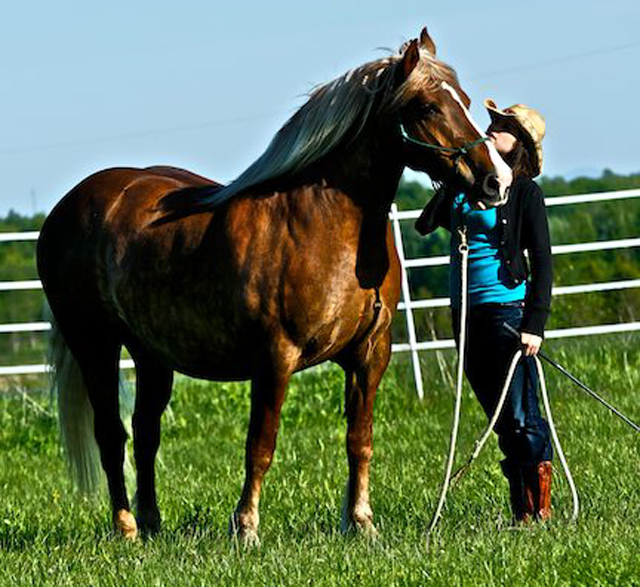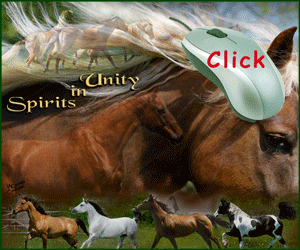
CFN – This Column of “Spirits in Unity” is being published by CFN for the community of Stormont, Dundas & Glengarry.
Today’s column is a compilation of thoughts inspired by various writings, talks and presentations of Horse Masters Pat and Linda Parelli as well as personal experiences with horses.
Matching the Physical
Use faster or slower motions with your body and your feet to:
– match the quickness of pace
– match the speed or encourage it forwards (on the ground is best)
– extroverts need you to move quicker and be more animated at first.
– introverts need you to move slower and be less animated at first.
You will know if you are being successful if your horse gets calmer and has more impulsion; self controlled forward energy.
Matching the Mental
You need to determine if your horse is thinking quickly, slowly or not at all. When he is scared, he is not thinking. He is just reacting out of pure instinct for survival. So calmness and confidence have to come first, then you’ll be able to play with your horse’s mind.
Left-Brain horses are thinkers. Right-Brain horses are able to think only when they are calm and confident.
Introverts are slow thinkers. Extroverts are quick thinkers.
When you get the introverts mind, he will give you his feet.
When you get the extrovert’s feet, he’ll give you his mind.
With introverts you need to go slower but mean more – be more intense with your concentration and more particular about what you want and how you want it. This is hard to do without feeling or acting critical, but if you let your horse know when he is right rather than get tougher when he is wrong, it will go just fine.
You will know it is working when your horse focuses on you, asks questions (by looking at you, ears forward) and when he learns or responds quickly to you. Quickly may still mean slower than what you want. Sometimes the speed depends on the horse’s individual nature and especially if he is extrovert or introvert. The extroverts are usually quicker.
Matching the Emotional
Emotional horses are tense, reactive, defensive, aggressive, afraid and even panicky.
Horses need to be able to move when afraid. After all they are flight animals. If you try to interfere with this instinct, he will panic. It is important not to make him feel trapped and let him move his feet.
Instead of trying to hold back an emotional horse, you need to help him release that emotion by allowing or encouraging him to move. The movement doesn’t have to be in a straight line. It can be in circles, back and forth, repetitive disengagements of the hindquarters that will help him calm down. In column #38 there is a video reference of right brain horse and how everyone was trying to shut down the energy and getting nowhere.
You must not hold the rope back. This will only intensify his fear. Movement will allow him to release adrenaline and calm down. For some horses this can take a long time, but you have to match the energy appropriately for as long as it takes.
Examples:
Suppose you are working on line and you know you might have a frantic horse on your hands. First use longer lead lines so he can drift farther and faster if he wishes without dragging you all over the place. Longer lines will give you more leverage as well so you will have a better chance of getting things under control. You have to move assertively so as to let him know that you are present. If he doesn’t even realize that you are even in the room, he is not likely to respond to you. Be firm, send him in circles, make him change directions (this makes him think) so he starts to see you as an effective leader.
When your horse is worried and can’t stand still, give him a task to do such as having him put his feet on something. Move him on circles and disengage his hindquarters often can be effective.
When a horse is tense, this is your best time to respond so do less sooner rather than more later. Retreat a little, move him forwards a little or maybe sideways, bend his ribs (partial disengagement). When you bend his ribs, it becomes difficult for him to maintain the tension. By keeping him moving it disperses his adrenaline. Your horse might be confused at first but politely and passively persist releasing as soon as he tries to do what you ask. Drop the level of energy in your body and stick etc. but keep a light feel on the lead line so he knows you have not abandoned him and will help him.
If your horse is an introvert, sometimes just stopping and waiting is enough to relieve the tension, because to the introvert moving him may feel like adding pressure instead of releasing it.
As for matching the emotion itself. That you don’t want to do. You can match the energy of it, but you have to remain emotionally and mentally calm and focused. If you are afraid, you are not going to provide the kind of leadership your horse needs.
Change when the Horse Changes
The moment that your horse changes, the moment he begins to slow down, calm down, lose tension, you have to match the new lower tension level or you will break rapport with him again and the cycle could start all over again. Work at getting your horse to learn that when he calms down you will calm down and not the opposite. He will think he is training you, but it was your idea all along. He will begin to like you calm much better.
Rapport
Gaining Rapport with a horse is not an easy task, but anyone can accomplish it. It will make everything you want to do with him easier. It can take a long time to build trust, but once you do, you will discover that everything else come faster because now you don’t have to constantly deal with suspicion, scepticism, and distrust. Resistances disappear, partnerships and harmony grow.
Horses like to be with horses they like. They also like to be with humans they like. You have to become what he likes. When he sees you in this light, he will give you all manner of wonderful things out of pure heart and desire. You can do it.
I am always amazed when I see horse masters like Pat Parelli and others when they are working with horses and how the horses seem to be always looking for Pat.
In column #38 we included videos of the extremes of certain horse personalities. On May 25 our “Spirits in Unity Team” will be participating in the annual Bike-a-thon Plus fundraiser for the Children’s Treatment Centre. There you will have the opportunity to meet some of the typical personality types. In particular you can meet a right brain extrovert and introvert who displayed all the same behaviour that you saw in the videos in that column for those types of personalities. You will also be amazed at the difference today after they have had the proper training based upon love, language and leadership in stead of intimidation and punishment. At the event you can have a ride on animals that are now calm and respectful and a joy to be around. Hope to see you there. Check out Poncho’s Pony Pals at the following website for details www.ctc-sdg.com
For all those people who give horses loving homes, and for all those kids who are wishing for that special partner, may all your dreams and your horse’s dreams come true also.
Whether you are just a horse lover, have dreams of owning a horse someday, or already have one, I hope these columns will give you some insight into the true nature of these magnificent creatures. I hope you will find them both informative and inspirational.
Please click on ‘like’ if you enjoyed this column and make a comment as well. We look forward to your feedback and questions.
Be part of your horse’s dreams, not his nightmares.
Garry “Horsetalker” Meek

